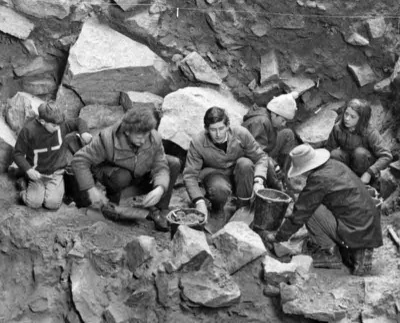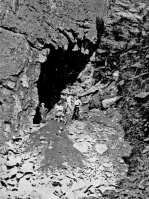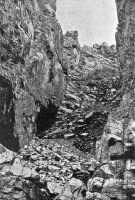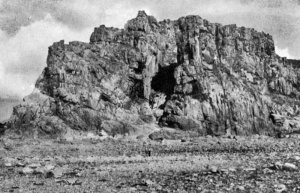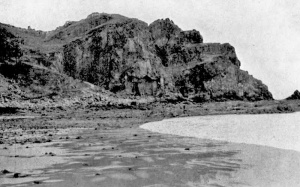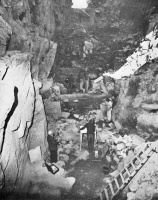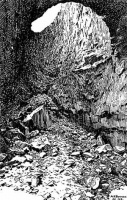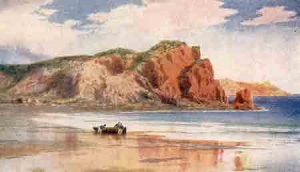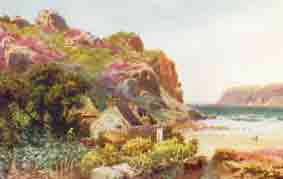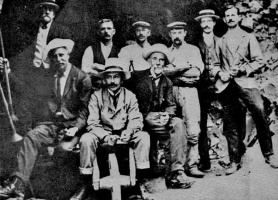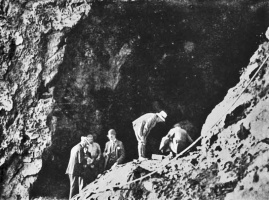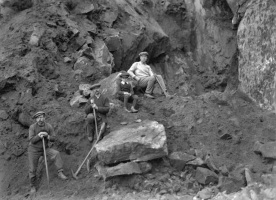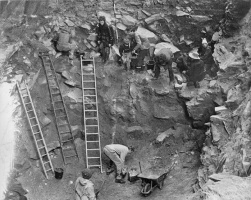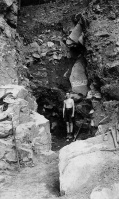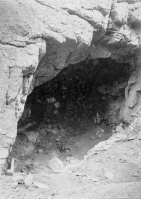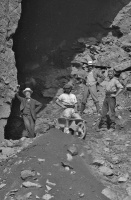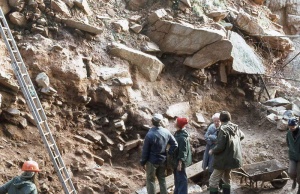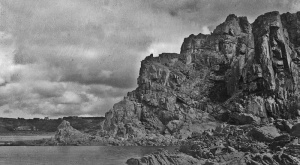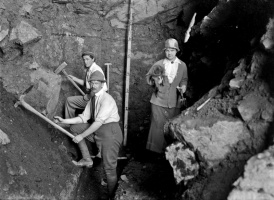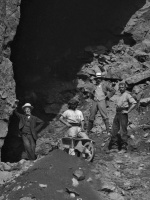Early excavations at La Cotte de St Brelade
A university team including Prince Charles take part in an archaeological dig at La Cotte
|
The recent purchase by our Society of the headland which encloses the famous Cotte de Saint Brelade terminates a period of over 70 years during which members of the Society in varying numbers and at various times, with or without the assistance of quarrymen, have dug their way into and removed many hundreds of tons of rubble and detritus which, during countless ages had partially filled the great gully without and choked almost completely the cave within.
Being one of the very few surviving, but casual, investigators of the 1890s, I have been asked to prepare a short summary of what has proved to be a three-generation task, for it began very sketchily in or about 1880 and is not likely to be fmished before 1960, at earliest.
Reports on the more serious investigations and excavations have been published from time to time in our annual Bulletins, and descriptions of some of the work have also appeared in Sinel's Prehistoric Times and Men of the Channel Islands, (1914); in Man, in Archseologia (Vols LXII, LXIII, and LXVII) and also in Hawkes' Vol II of The Archaeology of the Channel Islands, (1937); but it is from the Society's Bulletins, perhaps, that the fullest first-hand information may be obtained - especially as these reports are accompanied by plans, sections, and photographs which serve to illustrate, not only the progress of the excavations, but also the nature of many of the most important 'finds'.
The earliest report appears in the Bulletin for 1911. Thereafter each Bulletin until that of 1919, with the exception of that for 1914, contains a report. The authors of these reports, Edmund Nicolle, Joseph Sinel, R R Marett, and G F B de Gruchy, were men whose genius and energy spread the knowledge of the prehistory of their well-loved island outward from one of local limits to one of wider circles among the learned societies of England, France, and America; and in this admirable work they had the support of Emile Guiton's expert skill as a photographer and of Arthur Barreau's abilities as a pen-and-ink artist.
Gap in story
After 1919 a gap of over thirty years occurs in the story of the excavations and no further special reports were published until the Bulletin for 1951 was issued, when it was stated that excavations had also been made from 1936 to 1940 in the upper part of the ravine.
The reasons for this gap are not far to seek; for not only was it believed that the main occupation levels of the cave had been cleared out, but that deeper diggings into the still-existing mass of detritus would prove to be increasingly dangerous, expensive and unremunerative.
A halt was therefore called and the activities of the Society were concentrated on more promising objectives such as the Castles, La Hougue Bie, the Pinnacle and other kindred sites of historic or prehistoric interest.
La Cotte de Saint Brelade, therefore, to use a local phrase, was "lodged au Greffe" for the time being.
Three optimists
Nevertheless, and in spite of all this, there were optimists who did not believe that the Cotte had surrendered its last secrets and they were the three tireless toilers who had laboured with such success throughout six years at the Pinnacle; namely A D B Godfray, Father Christian Burdo and E A Lomax.
The somewhat ambitious purpose of the work they carried on in 1936-40, with the help of students from Maison St Louis, was to clear the whole of the ravine down to the level of the cave floor. They were only 15 feet above it, when World War II broke out, scattered the workers and stopped the whole scheme.
By 1951, however, the Society had had to mourn the loss of Major Godfray and Mr Lomax, and thus it has been left to Father Burdo alone to complete the good work.
60 years of excavations
From fantasy and fairyland to facts and fashioned flints: Being an abridged account, based on the Society's annual bulletins, of the excavations that have been carried out in the Grotte a la Fee, or cave at La Cotte, during the past 60 years
This cave was not noted for its prehistoric associations before 1881 when Messrs Dancaster and Saunders found a worked flint on the rocks beneath its entrance and traced it to the cave itself. They do not appear, however, to have made any further investigations.
In 1894 and 1895 Dr Chappuis and R Colson extracted many flint implements from the exposed floor of the cave, where the deposits seem to have been composed of a sort of rotten bone brecchia in which they were able only to find one tooth and one metatarsal of a horse.
In 1896 Colson took me there to work with him and we found a good number of flints without much labour, but as the spot we had mined was overhung by a loose and massive block of rock, we thought it prudent to abandon the work. And here I should state that the presence of huge blocks of this nature were destined to hamper and threaten the safety of many other future investigators as they dug their way further into the cave.
Random work of this kind, in which Emile Guiton, Stanley Guiton, and G A Piquet took part, continued until September 1905, when the Society decided to explore the cave in a more systematic manner and it was then that E T Nicolle, Dr Chappuis, and R Colson set to work on the exposed part of the floor already mentioned. Again they also found many implements and again they also were threatened by heavy blocks, and it soon became obvious that nothing further could be attempted until quarrymen were employed to deal with the great stones and dangerous downfalls.
Neandertal's man's teeth
With the permission of G F B de Gruchy, Seigneur de Noirmont, experienced quarrymen began to operate on 1 August 1910, and succeeded in clearing, after three years work, about eleven feet square of the floor at the left of the entrance to the cave. It was within this small area, in the presence of E T Nicolle, J Sinel, Dr Dunlop, Dr Chappuis, A H Barreau, Emile Guiton, and E Daghom (quarryman), that the most outstanding treasures of the cave were uncovered, namely the teeth of Neandertal man himself. These precious relics, together with others of rather less importance from the same area, were taken by Mr Percy Aubin to the British Museum of Natural History, where they were examined and reported on by Drs Woodward and Andrews.
These important discoveries naturally encouraged the Society to continue its search for others, in spite of the immensity of the task it might entail. Towards the end of September, however, Mr C Messervy, an engineer member of the Committee, advised that the work should be discontinued owing to the lateness of the season and the dangerous state of the rubble, clay and rock which would have to be removed. And thus a season which had given and promised so much, was brought to a close.
In August 1911 the same workmen returned to the attack and began to push the excavation inwards, but after removing the debris which had fallen from the roof since they had ceased work the year previous, they encountered a block of granite measuring eight feet in length by five feet in each other direction. To demolish this obstacle by means of explosives would undoubtedly have shaken down a mass of rock from the roof and sides of the cave, and the block, in consequence had to be split up by means of drills and wedges. The men were then able, with spade and pick to make vertical cuttings through the clay and rubble which had lain behind while other members of the party kept watchful eyes on the debris. During this operation four more human teeth were discovered, as well as quantities of flint chippings and implements and the bones and teeth of a variety of animals. As in 1910, all these teeth and bones were submitted to the experts in London and their reports were duly published in our bulletins.
When the exploration of this floor and hearth had been completed, a trench five feet wide and five feet deep was dug along the left-hand wall of the cave, but no further worked flints were found. The investigators therefore concluded that this main floor marked the original and only occupation by man of the cave.
1912 work
Passing now to 1912, let us cross the gully to note the exploration by R R Marett and G F B de Gruchy, later assisted by E Daghorn and his two quarrymen, of a small cave in the opposite cliff. Here, though a number of flakes and implements were found, the explorers, finding that so many more hundreds of tons of rubble and rock would have to be removed before the site was cleared, decided to suspend the work in September.
In 1913 the British Association appointed a committee to undertake a further exploration of the cave and made a grant of £50 to that end. The committee consisted of R R Marett (Chairman), A Keith, C Andrews, A Dunlop, G F B de Gruchy and R G Warton (secretary). The committee set Mr Daghorn and his two quarrymen to work in March and April 1914, and they cleared a considerable mass of the upper part of the cave filling, as well as a great accumulation of detritus from the mouth of the cave. This rubble, clay, and rubbish was found to be largely sterile, though one layer of brownish clay yielded a good many implements. All told, however, the year's excavations produced over three hundredweight of implements and chips (including hammer stones) and about 5,000 portions of bone, mostly very fragmentary. The committee, hoping for another grant, were of opinion that excavation into the rearward parts and lateral extension of the cave was likely to pay good dividends.
1915 grants
In 1915 the committee obtained even more than they had hoped for, for not only did the British Association oblige with another £50, but the Royal Society also made them a grant of £50. The committee thus were able again to employ Mr Daghorn who, however, owing to the war, had some difficulty in supplying competent workmen in sufficient numbers.
Operations began on 1 July and continued without a break until 3 September, on which day a real and disastrous break did occur - no less than the collapse of the roof of the cave and the descent of an avalanche of rock and rubbish onto the partially excavated floor beneath. When this disaster befell, there were nine persons at work in the cave, but they, warned that the roof showed signs of "creeping", gathered up their spoils and withdrew to safety before the roof came down with a roar.
Operations were now suspended for the autumn and winter to give time for the landslide to adjust itself and settle down so that work could be resumed in greater safety next year.
The excavations of 1915, which were terminated so abruptly, had produced, nevertheless, some remarkable finds, for besides adding many thousands of flint implements, and chips to the already huge collection that had been gathered in, they added fifteen new species to the list of animals already recorded.
The three following years, 1916, 1917, and 1918, were devoted mostly to the removal of the 500 tons of material which had fallen from the roof or had accumulated in other parts of the cave. This task was performed when, owing to the war, labour was not always procurable and had to be recruited from Victoria College or from the active and able visitors who had come over from Oxford to join Dr Marett. In this work and in the examination of the "Lemming beds" first discovered by E F Guiton in 1915, a great many more 'finds' were added to the ever-increasing collection of relics from the cave which in due course were submitted to the palaeontologists and osteologists of the British Museum of Natural History for scrutiny and report.
Animal discoveries
Though space will not permit me to give a detailed account of the flint implements which were garnered in thousands, a rough list of the quadrupeds and birds which had been identified since 1905 may now be offered: Mammoth, Elephant, Woolly Rhinoceros, Reindeer, Red Deer, Elk, Urus, Horse, Goat, Hyena, WolE, Hare, Rat, Rabbit, Shrew, and various species of Lemming: and among the birds were the Great Auk, several kinds of Geese, Ptarmigan, Moorhen, Dipper, Kestrel, and a small Wader?
Helpers
The 1918 season brought the first phase of excavations at la Cotte to a close and the second phase was not destined to open until nearly another thirty years had passed, the names of those persons, not being members of the Society, who had so ably assisted in the work of excavation or performed the difficult task of interpreting the finds, may now be placed on record once again: Sir Arthur Keith, Pres RCPS; Dr C Andrews, Brit Mus (Nat Hist), Dr Smith Woodward, Brit Mus (Nat Hist), Miss D M A Bate, Brit Mus (Nat Hist), Mr R J Fleming Struthers, Exeter College, Oxford, Mr F Brodie, Worcester College, Oxford, the Rev E G James, Exeter College, Mrs Jenkinson, Somerville College.
The following Victoria College boys were welcomed as diggers in the cave under Mr A J Robinson, the Science Master: J W Buck, F R Dorey, T D C Faed, B C Le Cras, C Le Marquand, W P Le Scelleur, D Poingdestre, R R Proud, J Pollock-Gore, and C F Watkin. Mr G Le Bas also helped.
The Second Phase of the excavations which began in 1936 only ran for four seasons before it was brought to an abrupt end by the onrush of the Germans and the Occupation of the Island by the enemy. When it reopened in 1950, it was inevitable that many changes would have to be faced. The cave itself was still there, and still partially filled with rubble, as also was the gully, but the older men who had organised or worked in the excavations were for the most part dead, and the young had grown up and gone away.
Father Burdo returns
It was therefore with pleasure and relief that members of La Société Jersiaise welcomed the return of Father Burdo from France, where he had endured many dangers and anxieties during the war without, it would seem, having lost any of his old interest in the cave or any diminution of his determination to complete the work he had so enthusiastically commenced.
The enterprise by now has become a "one man show" and from 1950 to the present moment Father Burdo has been in supreme command of the operations. Since, with such a reduced manpower, it could no longer be a question of clearing the whole width of the ravine, he opened a trench at a much lower level, 18 feet below the former cave floor. His first intention was to try and reach inside the cave the rock bottom, which had defied all previous attempts. But he entertained also a secret hope of discovering another stage of human occupation, older than that of Neandertal Man. This hope was fulfilled when, in June 1951, he struck an unquestionable Acheulian layer, vastly older than the previous finds.
With assistance from Ian Foster, Tony Medder, G A and A G Bouteloup, Keith Michaelson, all pupils from De La Salle College, and Robert Le Sueur, he has toiled in all weathers year after year, to reduce and sift the mass of rock, soil, clay, and detritus which remains in the cave, and to preserve all the thousands of flint implements and fragments of bone he uncovers in his work.
Further articles and links
- Mammoth Hunters - a Jersey Heritage article
- Pre-history, an introduction to Jersey's prehistoric sites
- La Cotte de St Brelade
Gallery
Click on any image to see a full-size version
A picture of the cave by Albert Smith

